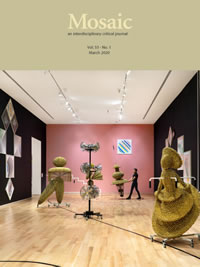Issue 53.1
Overview

Emerging Scholar Essay Prize
Published: March 2020
View the issue introduction or see the issue summary and contents below.
9 essays, totalling 176 pages
$24.95 CAD
This general issue features the winner and runner-up of the Mosaic Emerging Scholar Essay Prize, as well as essays on Elizabeth Bishop’s “At the Fishhouses,” biophilia and the poetry of Thomas Lux, domestic help in contemporary French fiction, and questions of naming in Michael Ondaatje’s Warlight. On its cover, the issue features the art of Haegue Yang.
Elizabeth Bishop’s Work of FirePhilip McGowan This critical reassessment of Elizabeth Bishop’s “At the Fishhouses” (1947) focuses specifically on the poem’s interweaving of fire and water imagery with questions of history and selfhood, and engages works by Feuerbach, Emerson, Bachelard, and Blanchot alongside Bishop’s drafts and other key materials held in the Vassar College archive. | |
Finster’s Finger: The Trans-Generational Art of Howard FinsterEyal Amiran Drawing on Jean Laplanche’s theory of seduction and Thelma Finster Bradshaw’s biography of her father, this essay reads key scenes in folk artist Howard Finster’s life and art to show that they stage his identity through trans-generational transferential relationships. | |
Should the Subaltern Clean?Sonja Stojanovic This essay investigates, through a reading of contemporary French fiction, the politics of naming “the help.” It considers how cleaning ladies are both rendered hypervisible and required to be invisible; it examines how they tidy up the narration, while performing what one could term a perverse effet de réel. | |
The Poetry of Thomas Lux: Biophilia Meets Theory of MindJudith P. Saunders Thomas Lux often scrutinizes the relationship between humans and their physical environment, illustrating biophilia in action: the continuing power of nature to fascinate, frighten, and repel us. He concludes that our perception of nonhuman life forms is distorted by cognitive predispositions that encourage species bias and illusions of specialness. | |
Queer Kinship in the Work of Nathalie Djurberg and Djuna BarnesErik Fuhrer This essay puts Donna Haraway’s “queer messmates” into conversation with Susan Stryker’s “creatures” in order to think about provisional queer kinship models in Djuna Barnes’s To the Dogs and Nightwood and Nathalie Djurberg’s Putting Down the Prey. | |
Uncertainty and the Time of the Stranger: Michael Ondaatje’s WarlightMike Marais This essay examines Michael Ondaatje’s portrayal of uncertainty as a response to the stranger in Warlight. Arguing that uncertainty signifies respect for the stranger’s opacity, it demonstrates that the narrator of this novel’s “self-portrait” is an account of his openness to others, and therefore to the past and the future. | |
Anthropocentric Ableism and Virginia Woolf’s FlushSebastian Williams Virginia Woolf’s Flush creatively imagines nonhuman experience, which in turn exposes and subverts an underlying anthropocentric ableism—particularly the ways speciesism and ableism are intimately connected. Exploring invalidism, eugenics, and canine perception, Woolf’s novel challenges the very meaning of a “normal” body, language, and literature. | |
Musical, Lyrical, Universal? Neruda’s Amor into Barber’s LoversHelen Plevka Through its power to translate transnationally, music is often perceived as a kind of universal language, yes this movement must be studied within the contexts of its creation and reception. By considering the “musicalization” of Pablo Neruda’s Veinte poemas de amor y una cancion desesperada into Samuel Barber’s The Lovers Op. 43, this essay uses musico-literary theory to offer a new way of reading and hearing meaning across cultural spaces. | |
Fabled Difference: Approaching Race in Marie de FranceAnnika Pattenaude Because Marie de France’s Fables allegorizes twelfth-century feudal relations, its strategic essentialisms are easily read as products of medieval class-based hierarchies. But recent work in medieval studies proposes that the classist hierarchies portrayed in the Fables were imbricated with racial thought—or even that the two were constitutive of one another. |